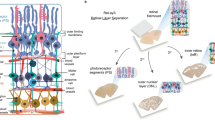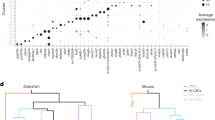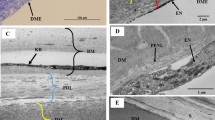Abstract
THE ‘R’ membrane was the name coined by Brindley1 for a hypothetical retinal barrier whose penetration by a microelectrode advancing from the vitreous chamber results in a marked drop in electrical resistance and decrease in capacitance. Later, Tomita, Murakami and Hashimoto2 found that this barrier could be demonstrated in eyes from which the retina was removed, thus placing the barrier behind the retina either at the level of the pigment epithelium or at Bruch's membrane. This was afterwards confirmed by Brindley3. Since the membrane of Bruch appears to be a substantial structure in light microscopy, it was a likely candidate for the ‘R’ membrane. Electrode marking methods employed by Brown and Tasaki4 gave results compatible with this hypothesis and ruling out the retina although in fact not clearly marking Bruch's membrane as distinct from the pigment epithelium. Cohen5, using electron microscopy, cast doubt as to the role of Bruch's membrane in this phenomenon by pointing out that Bruch's membrane consisted of the basement membranes of the pigment epithelium and choroid capillaries together with a layer of loosely interwoven connective tissue. Since there is a basement membrane at the retinal-vitreous junction where no electrical change of a comparable type is noted, it seemed unlikely that Bruch's membrane had the requisite structure for significant electrical resistance.
This is a preview of subscription content, access via your institution
Access options
Subscribe to this journal
Receive 51 print issues and online access
$199.00 per year
only $3.90 per issue
Buy this article
- Purchase on Springer Link
- Instant access to full article PDF
Prices may be subject to local taxes which are calculated during checkout
Similar content being viewed by others
References
Brindley, G. S., J. Physiol., 134, 339 (1956).
Tomita, T., Murakami, M., and Hashimoto, Y., J. Gen. Physiol., 43, Suppl. 2, 81 (1960).
Brindley, G. S., Physiology of the Retina and the Visual Pathway (Arnold, London, 1960).
Brown, K. T., and Tasaki, K., J. Physiol., 158, 281 (1961).
Cohen, A. I., Exp. Eye Res., 1, 128 (1961).
Cohen, A. I., Amer. J. Anat., 107, 23 (1960).
Fine, B. S., Arch. Ophth., 66, 847 (1961).
Cohen, A. I., Devel. Biol., 3, 1 (1961).
Sauer, F. C., J. Morph., 61, 563 (1937).
Klinkerfuss, G., Amer. J. Anat. (in the press).
Farquhar, M., and Palade, G., J. Cell Biol., 17, 375 (1963).
Robertson, J. D., Prog. Biophys. Biophys. Chem., 10, 343 (1960).
Kuffler, S. W., and Potter, D. D., J. Neurophysiol., 27, 290 (1964).
Rodriguez-Peralta, L., Anat. Rec., 142, 273 (1962).
Author information
Authors and Affiliations
Rights and permissions
About this article
Cite this article
COHEN, A. A Possible Cytological Basis for the ‘R’ Membrane in the Vertebrate Eye. Nature 205, 1222–1223 (1965). https://doi.org/10.1038/2051222a0
Published:
Issue Date:
DOI: https://doi.org/10.1038/2051222a0
This article is cited by
-
Is your vitreous really necessary?
Eye (1987)
-
Pathogenesis of central serous retinopathy: A new working hypothesis
Graefe's Archive for Clinical and Experimental Ophthalmology (1986)
-
Fine structure of the retinal epithelium and retinal tapetum lucidum of the goldeye Hiodon alosoides
Anatomy and Embryology (1982)
-
Fine structure of the retinal epithelium and tapetum lucidum in the giant danio (Danio malabaricus) (Teleost)
Anatomy and Embryology (1980)
-
Electron microscopy of retinal tapetum (Caiman crocodilus)
Albrecht von Graefes Archiv f�r Klinische und Experimentelle Ophthalmologie (1978)
Comments
By submitting a comment you agree to abide by our Terms and Community Guidelines. If you find something abusive or that does not comply with our terms or guidelines please flag it as inappropriate.



